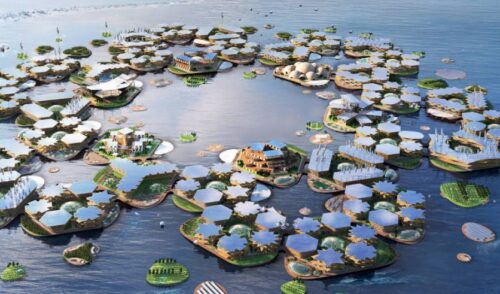Global Travel News
UN-Habitat and OCEANIX Unveil World’s First Floating City

The challenge is massive: two out of every five people in the world live within 100 kilometers of the coast, and 90 percent of mega cities worldwide are vulnerable to rising sea levels. Flooding is destroying billions of dollars worth of infrastructure and forcing millions of climate refugees to leave their homes. With nowhere to expand, rapid urban population growth is pushing people closer to the water, driving housing costs to prohibitive levels, and squeezing the poorest families out.
“Today is a pivotal milestone for all coastal cities and island nations on the frontlines of climate change. We are on track to delivering OCEANIX Busan and demonstrating that floating infrastructure can create new land for coastal cities looking for sustainable ways to expand onto the ocean, while adapting to sea level rise,” said the Chief Executive Officer of OCEANIX, Mr. Philipp Hofmann.
OCEANIX, a blue tech company based in New York, led a team of the world’s best designers, engineers, and sustainability experts in designing the flood-proof prototype. The BIG-Bjarke Ingels Group and SAMOO (Samsung Group) were the lead architects of OCEANIX Busan, unveiled at the Second UN Roundtable on Sustainable Floating Cities; a follow up to the inaugural Roundtable in April 2019, where it was agreed to build a prototype with a host city. Busan signed on last year.
“As Mayor of the Metropolitan City of Busan, I take seriously our commitment to the credo ‘The First to the Future’. We joined forces with UN-Habitat and OCEANIX to be the first to prototype and scale this audacious idea because our common future is at stake in the face of sea level rise and its devastating impact on coastal cities,” said Mayor Park Heong-joon, who has set an ambitious agenda, including turning Busan into a green smart city and launching a bid for World Expo 2030.
Speaking at the Roundtable, which took place at the UN Headquarters in New York, and was attended by government ministers of housing, Mayors, Ambassadors, and high-ranking UN officials, the Executive Director of UN-Habitat, Ms. Maimunah Mohd Sharif said. “We cannot solve today’s problems with yesterday’s tools. We need to innovate solutions to global challenges. But in this drive for innovation, let’s be inclusive and equitable and ensure we leave no one and no place behind. I am happy this Roundtable takes place ahead of the High-Level Meeting on the New Urban Agenda, where cities and countries around the world come together to discuss sustainable urbanization.”
“In designing a solution for the most vulnerable coastal locations on the frontlines of climate change, OCEANIX’s new modular maritime neighborhoods will be a prototype for sustainable communities informed by Busan’s unique juxtaposition of old and new. Creating a connection between the city and the seaside, OCEANIX Busan will expand this spirit onto the waterfront,” said Bjarke Ingels, Founder and Creative Director of BIG-Bjarke Ingels Group.
OCEANIX Busan is the world’s first prototype of a resilient and sustainable floating community. The interconnected neighborhoods total 6.3 hectares to accommodate a community of 12,000 people. Each neighborhood is designed to serve a specific purpose – living, research, and lodging. There are between 30,000 to 40,000 square meters of mixed-use programs per neighborhood. The floating platforms connect to the land with link-span bridges framing the sheltered blue lagoon of floating recreation, art, and performance outposts. The low-rise buildings on each platform, defined by their soft lines, feature terraces for indoor-outdoor living, helping to activate the network of vibrant public spaces. OCEANIX Busan will organically transform and adapt over time. Starting from a community of 3 platforms with 12,000 residents and visitors, it has the potential to expand to more than 20 platforms. The floating platforms are accompanied by dozens of productive outposts with photovoltaic panels and greenhouses that can expand and contract over time based on the needs of Busan. OCEANIX Busan has six integrated systems: zero waste and circular systems, closed loop water systems, food, net zero energy, innovative mobility, and coastal habitat regeneration. These interconnected systems will generate 100% of the required operational energy on site through floating and rooftop photovoltaic panels. Similarly, each neighborhood will treat and replenish its own water, reduce and recycle resources, and provide innovative urban agriculture.
OCEANIX is a blue tech company founded by Itai Madamombe and Marc Collins Chen in 2018 to design and build floating cities for people to live sustainably on the ocean. OCEANIX design and engineering partners on the Busan prototype include: Prime Movers Lab, BIG-Bjarke Ingels Group, SAMOO Architects and Engineers, Arup, Bouygues Construction, Helena, the MIT Center for Ocean Engineering, the Korea Maritime and Ocean University, top environmental artist Olafur Eliasson and Studio Other Spaces, Wartsila, Transsolar KlimaEngineering, Mobility in Chain, Sherwood Design Engineers, Agritecture, the Center for Zero Waste Design, Greenwave, and the Global Coral Reef Alliance.
UN-Habitat, works to promote socially and environmentally sustainable cities and human settlements. UN-Habitat’s vision is to achieve “a better quality of life for all in an urbanizing world”. It works in over 90 countries to promote transformative change through knowledge, policy advice, technical assistance and demonstration projects.
Busan, a city of 3.4 million residents, is the second largest city in the Republic of Korea. It is home to the biggest industrial complex in the Southeast Economic Region of Korea. Busan is one of the most important maritime cities of the 21st century, making it a natural choice to deploy the sustainable floating city prototype with its marine engineering capabilities.












 Cité du Vin
Cité du Vin
 Wine Tourism
Wine Tourism
 Wine Talks
Wine Talks
 France Vineyards
France Vineyards